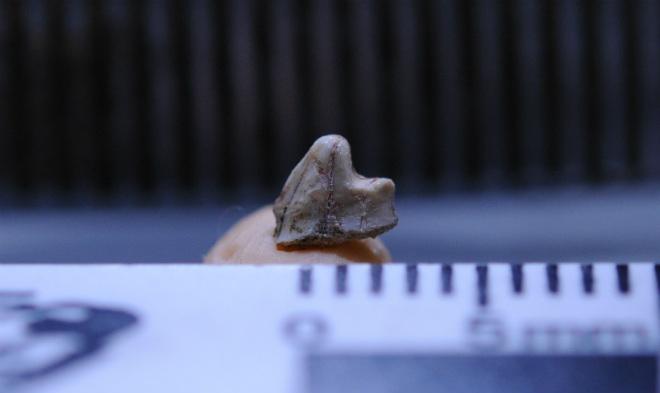
Credit: Mariela Castro
Brasilestes stardusti is the name given to the oldest known mammal found in Brazil. It lived in what is now the northwest of São Paulo State at the end of the Mesozoic Era between 87 million and 70 million years ago. It is the only Brazilian mammal known to have coexisted with the dinosaurs.
The discovery of Brasilestes was announced on May 30, 2018, by a team led by Max Langer, a professor at the University of São Paulo's Ribeirão Preto School of Philosophy, Science & Letters (FFCLRP-USP). Langer's team included colleagues at the Federal University of Goiás and the University of Campinas in Brazil, La Plata Museum in Argentina, and the Massachusetts Institute of Technology (MIT) in the US.
Physically speaking, Brasilestes consists of a fossilized premolar tooth with a maximum crown length of 3.5 mm. "The tooth is small and incomplete: the roots are missing," said paleontologist Mariela Cordeiro de Castro, first author of the paper recently published in Royal Society Open Science.
"Small but not tiny," Castro continued. "Although it's only 3.5 mm, the Brasilestes tooth is three times bigger than all known Mesozoic mammal teeth. In the age of the dinosaurs, most mammals were the size of mice. Brasilestes was far larger, about the size of an opossum."
The name of the new species pays tribute to British rock star David Bowie, who died in January 2016, a month after the fossil was found. Brasilestes stardusti alludes to Ziggy Stardust, an extraterrestrial character created by Bowie for a 1972 album.
The research was supported by the São Paulo Research Foundation – FAPESP as part of the thematic project "The origin and rise of dinosaurs in Gondwana (late Triassic-early Jurassic)" , for which Langer is principal investigator.
The fossilized tooth was found in a rocky outcrop of the Adamantina Formation in General Salgado, São Paulo State. The rocks are in a field on a ranch called Fazenda Buriti.
"We were visiting Mesozoic outcrops when Júlio Marsola [another member of the team], keen-sighted as a lynx, spotted a small tooth sticking up out of a rock," said Castro, a professor at the Federal University of Goiás (UFG).
"The General Salgado deposits are well-known. Several Mesozoic crocodiles have come from them. The particular outcrop where I found Brasilestes is interesting, with dozens of fragments of Mesozoic crocodile eggshells. I bent down to look more closely at a small part of the outcrop to see if there were any eggshells and spotted the tooth. If it had stayed out in the open like that for a few more days, the rain would have swept it away.
"When I noticed what appeared to resemble the base of the tooth's two roots [the roots themselves have broken off], I thought it must be a mammal. Laboratory analysis gave us the certainty that it is indeed from a mammal."
A placental mammal in the Botucatu Desert
While a mere 3.5 mm tooth, especially an incomplete one, may seem insufficient to describe a new species of mammal, in actual, fact extinct mammals are frequently described on the basis of a single fossilized tooth.
This is because teeth are the most durable part of the mammalian skeleton. After all, they have to withstand the wear and tear of chewing for an entire lifetime. In contrast, many fish species and reptiles, for example, grow new teeth continually throughout their lives. Indeed, mammalian teeth are often the only skeletal remains that stay intact long enough to become fossilized.
The fact that a single premolar is all that is left of Brasilestes and that it is incomplete prevented the researchers from distinguishing with absolute confidence the group of mammals to which the species belonged. They know the tooth belonged to a therian, a member of a large subclass of Mammalia that includes marsupials and placentals.
Although there is not enough evidence to support the inclusion of Brasilestes in either infraclass, the researchers believe (but cannot categorically conclude) it was a placental mammal. If so, the fossil is unique.
Today, there are three major groups of mammals, namely, placentals, marsupials and monotremes. All three evolved during the Mesozoic Era. At that time, however, they were by no means the only groups of mammals. There were also multituberculates, which were common in the northern hemisphere, as well as groups typical of the southern hemisphere such as meridiolestids and gondwanatherians – named for Gondwana, the ancient southern supercontinent that gave rise to Africa, South America, Australia, Antarctica, and India.
The first Mesozoic mammal fossils were found in Argentinian Patagonia in the early 1980s, and some 30 species are now known. Until the Brasilestes announcement, these were the only ones found in South America. None remotely resembles the little tooth found in Brazil.
"When I showed the Brasilestes fossil to Edgardo Ortiz-Jaureguizar, a paleontologist at La Plata Museum, he was very surprised. He said he'd never seen anything like it, and at once showed it to another specialist at the same institution, Francisco Goin, who had the same reaction. Goin said Brasilestes resembled no other Mesozoic mammal found in Argentina, hence in South America," Castro recalled.
Among the 30-odd Argentinian species of Mesozoic mammals, there are meridiolestids, gondwanatherians, and even a few suspected multituberculates. There are no marsupials or placentals. The only fossils in these two groups found in South America date from after the mass extinction that wiped out the dinosaurs 66 million years ago in an event that marks the end of the Mesozoic and the onset of the current geological era, the Cenozoic.
Until the discovery of Brasilestes, the only traces of Mesozoic mammals in Brazil were hundreds of tracks and footprints left by unknown creatures 130 million years ago as they traversed the dunes of the Botucatu Desert in what is now São Paulo State. The solidified surface of those dunes has been preserved as sandstone slabs on which the footprints can be seen.
In 1993, Reinaldo José Bertini , a professor at São Paulo State University (UNESP) in Rio Claro, announced the discovery of a mammalian jawbone fragment with a single tooth far smaller than the Brasilestes premolar. However, Bertini did not publish a detailed study of the fossil and therefore could not name a new species.
"Brasilestes is not just the first Brazilian Mesozoic mammal to be described but also one of the few Mesozoic mammals found in more central regions of South America. The Argentinian fossils were found in geological formations in Patagonia, the southern tip of the continent," Langer said.
"Furthermore, Brasilestes is different from everything found before, suggesting that possibly placental mammals inhabited South America between 87.8 million and 70 million years ago," said the FAPESP thematic project coordinator.
New species possibly related to a mammal from India
Even more surprisingly, the Mesozoic mammal with premolars that most resemble the Brasilestes tooth lived on the other side of the world, in India, between 70 million and 66 million years ago. Its name is Deccanolestes. No other creature in the global fossil record is so similar to Brasilestes.
How could two members of the same lineage have lived so far apart in unconnected regions? Approximately 100 million years ago, when South America and Africa had only just been separated by the opening of the South Atlantic, India was breaking away from Gondwana and starting to wander through the Indian Ocean.
This implies that at least 100 million years ago, the ancestors of Brasilestes and Deccanolestes populated the Gondwana supercontinent. In other words, the lineage to which Brasilestes and Deccanolestes belong is far older than the ages of their fossils – between 87 million and 70 million years ago for Brasilestes, and between 70 million and 66 million for Deccanolestes.
"The discovery of Brasilestes raises many more questions than answers about the biogeography of South American Mesozoic mammals," Langer said. "Thanks to Brasilestes, we've realized that the history of Gondwana's mammals is more complex than we thought."
Finding triggers speculation on xenarthrans' origins
This could give rise to new hypotheses and new lines of investigation. Who knows, for example, whether future research inspired by the discovery of Brasilestes will reveal the origin of a typical South American group, the xenarthrans, the order of armadillos, anteaters and sloths? Castro's main research interest, in fact, is the evolutionary history of the xenarthrans.
"An interesting feature of the Brasilestes premolar is its superthin enamel, which is only 20 micrometers thick. The Brasilestes enamel is the thinnest of any Cretaceous mammal in the fossil record. Most Mesozoic mammals have enamel in the range of 100 to 300 micrometers," Castro said.
"Tens of known species of xenarthrans are alive now. Hundreds are extinct. Only three have enamel. The microstructure of Brasilestes' premolar enamel is very similar to that of the nine-banded armadillo," said the FAPESP-supported researcher.
According to Castro, "molecular clock evidence suggests the xenarthran lineage started at least 85 million years ago. However, the oldest armadillo fossils, found in Rio de Janeiro, are about 50 million years old".
While it is intriguing to imagine Brasilestes as an ancient xenarthran, it is far too soon for any such affirmation.
"The age and provenance of Brasilestes do match molecular hypotheses for the origin of the xenarthrans, but it would be premature to infer taxonomic affinity in light of the morphological differences between the Brasilestes tooth and armadillo teeth," Castro said.
Langer agreed. "We have only one Brasilestes fossil. That's nowhere near enough to extract conclusions from the fossil record," he said.
The fact that no Mesozoic mammal fossils were found in Brazil before Brasilestes could mean such fossils are rare or too fragile to be preserved. "Who knows, one day we may find new Brasilestes fossils that help us understand its history better. It could take decades," Langer said.
###
About São Paulo Research Foundation (FAPESP)
The São Paulo Research Foundation (FAPESP) is a public institution with the mission of supporting scientific research in all fields of knowledge by awarding scholarships, fellowships and grants to investigators linked with higher education and research institutions in the State of São Paulo, Brazil. FAPESP is aware that the very best research can only be done by working with the best researchers internationally. Therefore, it has established partnerships with funding agencies, higher education, private companies, and research organizations in other countries known for the quality of their research and has been encouraging scientists funded by its grants to further develop their international collaboration. For more information: http://www.fapesp.br/en.
Media Contact
Joao Carlos da Silva
[email protected]
55-113-838-4381
@AgencyFAPESP
http://www.fapesp.br
Original Source
http://agencia.fapesp.br/27995 http://dx.doi.org/10.1098/rsos.180482




